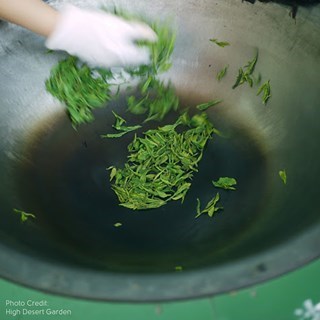Jasmine Jade Butterfly
The leaves that go into Jasmine Butterfly in Love come from the very top of the plant. Just the leaf bud and very young leaves are picked, and are then processed to make green tea.
Share The Love
What Is It?
Guided by expert tea taster Mark, we're delighting your senses with a refreshing, floral green tea - Jasmine Jade Butterfly which is also know as Jasmine Butterfly in Love. This is a lovely green tea from southern China. It gets its name from its delicate butterfly shape, made from tea leaves woven together in two bows.

Jasmine Jade Butterfly
Rare, fragrant bows of jasmine scented green tea. Country of origin: China - Yunnan Province
Where Is It From?

Jasmine Jade Butterfly is made in China's southern provinces, where the warm Pacific climate creates the perfect conditions for growing many of our favourite white and green teas.
This region is also quite rural, so tea makers often use tried and tested methods that have been passed down from generation to generation.
How Is Jasmine Butterfly In Love Green Tea Made?
The leaves that go into Jasmine Jade Butterfly come from the very top of the plant. Just the leaf bud and very young leaves are picked, and are then processed to make green tea.
Green teas are made from leaves that have not been allowed to oxidise - when the enzymes in them react with oxygen, causing them to turn brown and become black teas. To make green tea, fresh tea leaves must be heated, either in a large wok or by steaming, to kill the enzymes that cause oxidation. This keeps them green in colour.
Jasmine Jade Butterfly is made from steamed leaves, but it's the next stage that's really tricky. While the leaves are still supple, the tea producer makes them into a delicate bow. Then another little jasmine leaf bow is wrapped around the middle to form a butterfly. This lovely shape isn't just for appearance, but creates a beautiful tea, skilfully handcrafted to combine the best green tea leaves with a gentle infusion of jasmine.


What's The Grade?
Tea leaves go through a complex grading system before they reach the teapot. Grades are used to describe the condition and quality of the leaf, such as its size and whether it is whole or broken.
The most valuable and high-quality part of the tea plant is the very top leaf buds and young, tender leaves. These are graded as 'orange pekoe'. Broken leaves and small fragments left over once these leaves have been collected are known as 'fannings' or 'dust', and usually go into teabags.
Grading systems and terms can differ from country to country - what is called orange pekoe in India and Sri Lanka is simply termed 'high grade' in China.
As discussed above, Jasmine Jade Butterfly is made from the leaf bud and just one very young leaf, which means it is a high grade green tea. Its name also reflects how Chinese teas are classified by their appearance, in this case its delightful butterfly shape.

| Grades | Abbreviation | Source |
|---|---|---|
| Whole Leaf Grades | GFOP, FOP, OP | Orthodox Manufacture Only |
| Brokens | FBOP, BOP, BP | Major products from rotorvane manufacture only |
| Fannings | BOPF, OF, PF | Major products from CTC manufacture |
| Dusts | PD, RD | Major products from CTC manufacture |
Brewing, Serving And Tasting Your Tea

There are a number of ways you can brew Jasmine Butterfly in Love, each offering a unique tasting experience.
We've used our two-and-a-half-litre china teapot as well as a gaiwan, a traditional Chinese bowl for tasting tea. For our teapot we'll need five or six teaspoons of Jasmine Butterfly in Love, but if it's just a refreshing tea for one, a single teaspoon will do.
As we've said before on Tea Tasters, we recommend heating your water to just before the rolling boil, then letting it cool for two or three minutes so as not to scald the leaves. When your water's ready there should be just a gentle steam coming off the top, and then it's time to make your tea.

For a perfect pot, add your water and leave to brew for around three and a half minutes. This is our recommended time for letting the tea infuse and release all those wonderful jasmine flavours and aromas, but you could experiment with different brew times to find a taste that suits you.
If you're using a gaiwan, use just two pinches of tea then fill with water up to about a centimetre from the top, to leave room for sipping. The great thing about using a gaiwan is tasting the tea throughout its brew cycle for different intensities of flavour. Try your tea after 30 seconds for a light, delicate taste - or after a minute or two to appreciate this sublime tea's full depth.
And, if you fancy a light snack at the same time, afternoon tea favourites like cucumber sandwiches would go very well.

Aside from the taste itself, one of the pleasures of making tea is enjoying how it looks. We use traditional white crockery at our tastings, as this draws out the subtleties of fine tea colour. The popular glass teapots are also a wonderful way of watching the colours develop as the tea infuses.
Jasmine Butterfly in Love looks as delightful as it sounds: a beautiful golden liquor with a transparent shimmer on the surface. And it tastes absolutely sublime, with a heady, floral aroma and character that floats just above the refreshing green tea base.
So, that's Jasmine Butterfly in Love… and until next time, happy tea times.
Jasmine Jade Butterfly Video
Our master blender Mark talks you through the wonder of this fabulous green tea.
Watch now >
Jasmine Jade Butterflies in Love - Twinings Tea Tasters
